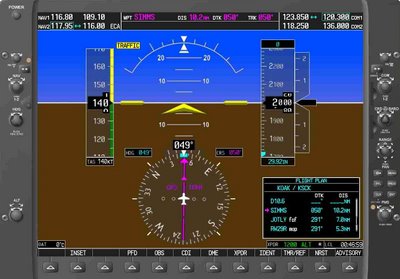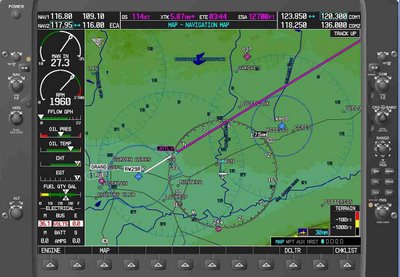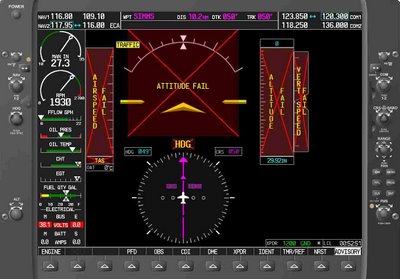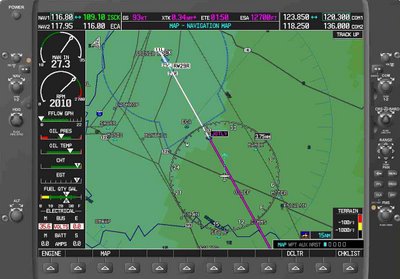
When I do G1000 checkouts for instrument-rated pilots, I like to give a demonstration of just how primitive things could get if certain equipment failed. After they have shown proficiency with full panel and reversionary mode, I give that a scenario that involves an instrument approach with the simulated failure of the G1000's Air Data Computer/Attitude Heading And Reference System (ADC/AHARS). Without the ADC/AHARS, the Primary Flight Display's (PFD) airspeed tape, altitude tape, VSI, attitude and heading are blank and covered with red Xs. And you thought there was no challenge to flying partial panel in a G1000-equipped aircraft?

You may find yourself wondering how likely the failure of the ADC/AHARS might be. While it's probably a lot less likely than a vacuum pump failure in a "steam gauge" aircraft, recent events have shown that unexpected AHARS failures are more likely than once thought.
Before you go pulling the two ADC circuit breakers in a G1000 172, it's important to know that when you do so your transponder will no longer have any altitude input and the transponder will lose mode C altitude reporting capability. Therefore, it's very important to 1) not do this exercise in airspace where mode C reporting is required nor 2) under IFR in instrument meterological conditions. I like to find a non-towered airport in Class E airspace. If we request a practice approach or flight following, I make a point of telling ATC that we will be practicing a simulated equipment failure, that our mode C altitude reporting will be temporarily unavailable, and that we'll report any altitude changes.
Without the ADC/AHARS, the KAP-140 autopilot becomes unusable except for ROL (wings level) mode and the pilot's scan becomes pretty weird. The pilot can look at the PFD to see their current track and desired track, but they must look at the steam gauge attitude indicator, airspeed indicator, and altimeter to control the aircraft. These steam gauges are not conveniently located and there is no rate-of-turn indicator, which adds to the challenge. And surely it wouldn't have cost Cessna that much to have put a mechanical slip indicator below the vacuum-driven attitude indicator. In fact, there is a turn coordinator mounted out of sight, behind the G1000 panels, which provides roll input for the KAP140 autopilot. Unfortunately, it's out of sight and not of much use.
Pulling circuit breakers to simulate failures is, as I mentioned in a previous post, controversial in some circles. The reasoning is that a circuit breaker is not a switch and shouldn't be used as such. I personally don't subscribe to this position, believing instead that providing a complete training experience for pilots outweighs concerns about a circuit breaker's useful life. I've been pulling circuit breakers for years to simulate gear failure and engine instrument failures with no ill effects. Having said that, I don't pull circuit breakers willy-nilly on each and every flight.
The least conveniently located instrument is the magnetic compass, which in a Cessna is mounted above the windshield. The good news here is that the GPS-derived ground track is probably more useful if you remember that when you change your heading there is a slight time lag before the ground track is updated. The pilot can also look at the Multi-Function Display (MFD) to see the moving map display, which can be a great help.

An even more difficult version of this scenario is to include a simulated failure of the PFD, which means you must use the MFD and you lose the inset moving map as well as the MFD's giant moving map display. If you want even more of a challenge, fly a non-precision approach in this configuration.

Flying this scenario in VMC is a great time to ask ATC for a practice no-gyro approach. If the controller grants your request, s/he will say something like "This will be no-gyro vectors to the Stockton ILS runway 2, make standard rate turns." The controller then instructs the pilot to "turn" or "stop turn." If the controller says "turn left," the pilot initiates a half standard rate turn to the left and responds "turn left." The pilot continues turning until the controller says "stop turn," which the pilot acknowledges and returns to wings level. This continues until the controller has the aircraft within 30 degrees of being established on the intermediate approach course segment.
A no-gyro approach requires skill on the part of the controller as well as the pilot. While there is no specific requirement for instrument-rated pilots to perform a no-gyro approach to maintain their instrument currency, the pilot must be proficient at flying straight and level, level turns, climbs, and descents with limited instrumentation. Air traffic controllers must perform a minimum of three ASR (approach surveillance radar) approaches every calendar quarter and many controllers appreciate the opportunity to practice them. Of course, the best time for a pilot to request a practice no-gyro approach is when the controller isn't busy. Don't ask for a no-gyro practice approach on a beautiful weekend when everyone is out flying.
Here are examples of intercepting and tracking the Stockton ILS 29R approach with the G1000 that has a failed ADC/AHARS.


This points up something that every pilot transitioning to the G1000 has pointed out - Why is the glideslope indicator only shown next to the attitude indication and not next to the HSI representation?

I've been asked a few times by pilots about to start training for their instrument rating whether it's better to start with steam gauges (the old fashioned, round indicators) or with a glass cockpit like the G1000. Starting initially with a primitive, steam gauge aircraft seems like a good choice and I think you can see why.
So get a safety pilot or an instructor to fly with you and try going back to the stone age. Yabba dabba do!














